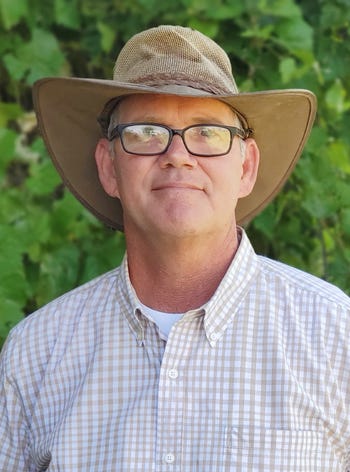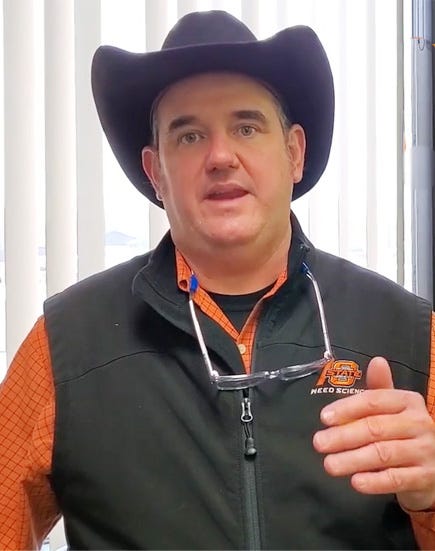
As farmers continue to complete their 2020 weed management program ahead of harvest and fall seeding, now is the time to start working on their 2021 plan.
Scouting and mapping trouble spots is a good first step, say weed specialists Pete Dotray, Texas A&M AgriLife Research and Extension Service, Lubbock, and Todd Baughman, Oklahoma State University, Ardmore.
 (Pete Dotray, Texas A&M AgriLife Research and Extension Service, Lubbock. Photos by Shelley E. Huguley)
(Pete Dotray, Texas A&M AgriLife Research and Extension Service, Lubbock. Photos by Shelley E. Huguley)

Keep Records
Dotray, who has a joint appointment with Texas Tech University, says, “start planning for 2021 now, based on what you see and what you remember through the season. Record where you identified lack of success; know where the trouble spots are. Pay attention to the recipes that worked or that need changed because they are not taking care of problems.”
“Keep an eye out for problems,” Baughman says. “If you see an escape, think about what kind of program you are using there and think about what the issue could be. Be vigilant, scout your fields now.”
He says resistant weed issues may not be as severe in the Southwest as they are in the Delta and the Southeast.
 (Todd Baughman, Oklahoma State University, Ardmore.)
(Todd Baughman, Oklahoma State University, Ardmore.)

“We’ve had resistance management protocols in place for Palmer amaranth for a long time in cotton,” he says. “Farmers have done a good job managing resistance in cotton and soybeans and cleaning up with Xtend and Enlist.
“Our farmers have been faithful about using pre-emergent herbicides and managing the new technology (dicamba and 2,4-D resistant varieties and complementary products) but not relying on it,” he says. “That’s the biggest key. We have to continue to do that.”
He says Oklahoma farmers are using Roundup and Liberty and Dual and Warrant in post tank mixes to add layers of control.
Manage Escapes
“We’re seeing some escaped weeds,” Dotray says.
“Farmers are chopping, hoeing, layby spot spraying, and doing whatever they can to slow weed growth,” he adds.
“We’ve seen success, especially in cotton, making sure that escapes are not producing seeds. Weeds that come up in August can still produce 20,000 seed. Even weeds emerging in September and October can produce seed.”
He says eliminating those escapes and preventing weed seed banks is particularly important considering the uncertainty of having the dicamba technology (Xtend) available next year.
Neither he nor Baughman see much “rescue herbicide” to control late-season heavy weed infestations.
But managing escapes is critical.
“We need to prevent the situation created with Roundup from occurring with Xtend and Enlist,” Baughman says.
They agree that weed maps or records — of trouble spot locations, as well as management programs — will help develop next year’s plan.
“This is a good time to evaluate what worked this year and what needs tweaked,” Dotray says. “Keep good records.”
He says drought took out most of the West Texas dryland cotton, and irrigated yields will suffer. “Producers did a good job controlling weeds in cotton still out there, but if something did not work right, determine if the problem is with residual or postemergence treatments. What is the perceived challenge?”
Game Plan
“Develop a game plan,” Baughman says. “Evaluate what worked and what didn’t this year. That’s a key this time of year. Consider individual fields; make notes, especially on problem fields.”
Dotray and Baughman expect dicamba technology to be available in 2021. They are not certain what the labels will look like, and the possibility, even if remote, exists that the products will not be renewed.
“Be realistic,” Dotray says. “Plan for two different scenarios for 2021 — if dicamba will be available or if not.
“Some weed management programs will work similarly, regardless of the technology. Burn down and start clean are important, regardless. If no dicamba, we will see more reliance on overlaying residuals and more timely Liberty applications with weed size limitations.”
He says he’s thinking the technology will be available, but producers should have a Plan B in place if it is not. “Even if EPA approves the label, the 9th Circuit Court could go after it again. Lots of hurdles remain, but we will work with growers to develop programs based on the options available.”
He says reports from herbicide manufacturers indicate some optimism and expect an EPA decision in early fall. “We hope it’s not late in the year, so growers will have time to make plans.”
Baughman says most of the farmers he works with had technology on hand to get through this season. “We did not see a lot of major issues. The technology was available. I hope EPA works with companies to get a label in 2021. The technology is definitely a benefit for growers, not only for resistant weeds but also for other hard-to-manage weeds like morning glory.
“Overall, we have clean fields and have seen excellent results with Xtend and Enlist. I hope we can keep the technology in the Southwest. Liberty can be a little erratic; timing is critical, so it is not the overall answer for us as it is in other areas.”
Dotray says he and others “at my level do not know what labels will look like. Manufacturers might have made some concessions, possibly a lot of concessions. States will have the option of applying for a 24-C registration to expand their options, but we need a federal label to build from.”
While agriculture awaits a decision, farmers need to put plans in place for 2021.
“Harvest is a good time to check on weed escapes,” Dotray says. “Recordkeeping now, recording observations of what you are seeing in the field now and during harvest, will help plan for next year. Be prepared to make modifications to improve weed management.”
“Plan for what to do if the technology is not available,” Baughman adds. He says if Xtend is not labeled, cotton and soybean producers may have trouble finding seed with Enlist technology, which has not been included in the lawsuits and ban.
“Notes on individual fields of what works best will be valuable in developing a program that will use other technology.”
“Be as diversified as possible,” Dotray says. “Success in 2020 is important, but it is critical not to rely on the same recipe every year. Liberty and Roundup should remain part of the program, along with dicamba. Do not rely on one chemistry.”
About the Author(s)
You May Also Like






